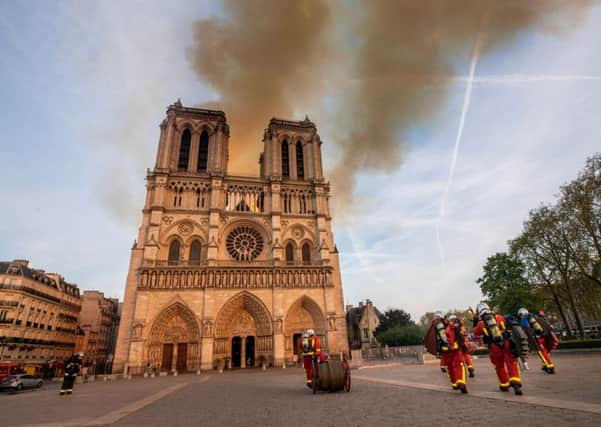David Behrens: Tragedy at Notre-Dame is a reminder of our shared history


The tragedy at Notre-Dame reminded us on this Easter week of the fragility of our most precious buildings. It was, as the architect in charge of Westminster Abbey put it, “exactly what we all dread to see”.
Advertisement
Hide AdAdvertisement
Hide AdYet there was consolation to be drawn from the conflagration. The rescue of many priceless artworks and religious artefacts from the cathedral, and its survival of wholesale destruction, was proof enough for some that divine intervention had been at hand.


Indeed, the shaft of golden light that pierced the remains of the roof and illuminated the cross and altar, even as smoke swirled below, was, literally, a sign from the heavens.
Barometric phenomena aside, there is no more substance to this than there was to the widely propagated view in 1984 that the lightning bolt which struck the Minster was God’s revenge for the consecration that had taken place there three days earlier of a Bishop who did not believe in the virgin birth or the resurrection.
But that isn’t the point. The emotion stirred in millions around the world on Monday night was genuine and sincere. Even if they did not worship there, Notre-Dame connected them with the human history we all share. Its religious, architectural and literary significance makes it one of the most beloved buildings in the world, and we had taken it for granted.
Advertisement
Hide AdAdvertisement
Hide AdNowhere was the emotion more raw and palpable than just outside the cathedral precinct. As flames engulfed the roof and all looked lost, a choir gathered and gave a pitch perfect rendition of Ave Maria. It was, observed a colleague, as if they were watching the world come to an end.
Within three evenings, the mood had turned. At the behest of the Archbishops of York and Canterbury, church bells across England rang out. For seven minutes on Thursday, they pealed in solidarity with Paris – not in mourning but in glory.
The French President, Emmanuel Macron, has set a target of just five years to rebuild the cathedral – even more beautifully than before, he said. That the French will succeed, just as the craftsmen did in York, there is no doubt. In all probability, it will be finished before Brexit.
History tells us that rebuilding and renewal is just part of the life cycle of our ancient temples – stone phoenixes, Dr Emma Wells, from the University of York, called them – reminders that out of adversity we may be reborn. They have changed many times through the centuries to become the living monuments we know today.
Advertisement
Hide AdAdvertisement
Hide AdIn the North York Moors National Park, the little church of St Mary’s, near the hamlet of Over Silton, is at the other end of the ecclesiastical estate. It is of a similar age to Notre Dame, around 850 years, but it accommodates no more than 50 people, and only if they breathe in.
Like Our Lady of Paris, it attracts pilgrims – hikers mostly, who stumble upon it by chance, for it stands in a field, accessible only by foot. There is no record of how many have seen it; certainly fewer than the 30,000 who poured into Notre-Dame each day, but in its own small way it is as much cherished by the community it serves. In fact, it has outlasted its original flock by several centuries. The Black Death seems to have done for them, and the present-day hamlet is the best part of a mile away.
St Mary’s has neither electricity nor water, and it needs a new roof. Consequently, it is open for worship only in the warmer months, and its first service of the year is this Easter weekend.
Thanks to a grant from the lottery, and the generosity of a few others, it was able to announce on Good Friday that it will get its roof repaired and sundry other improvements, and will stand for generations more, an unchanging symbol of the turbulent world around it.
Advertisement
Hide AdAdvertisement
Hide AdOn this weekend of resurrection, the importance of buildings like this, great and small, could not be more pertinent. They are spiritually important to only some of us, but they bind us all on some level, and their loss would be everyone’s loss.